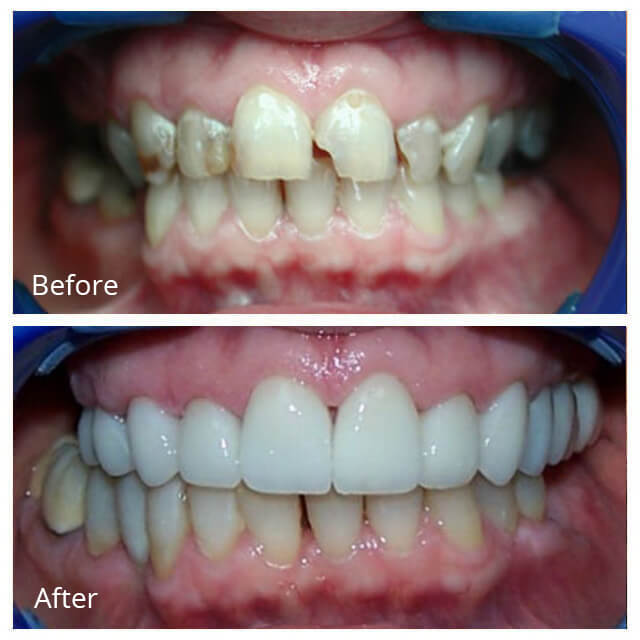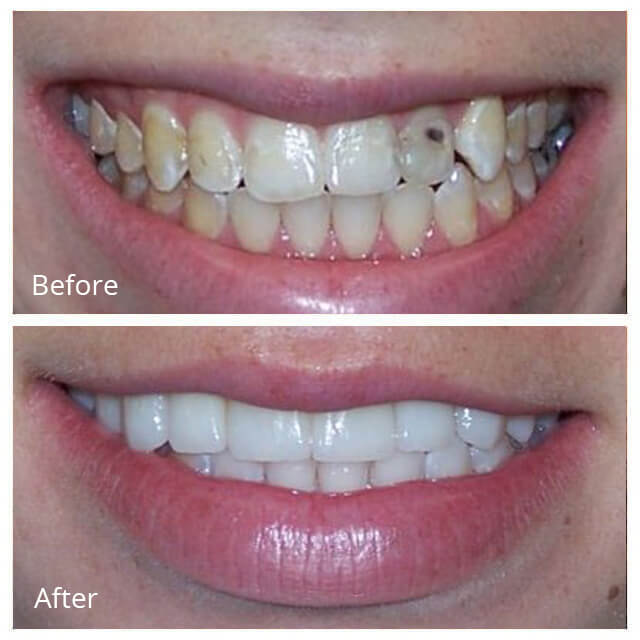When dental decay or damage does happen, you can trust Dr. Ilya Livshin and the Landmark Dental team to offer fast, effective care to relieve pain, restore form and function, and renew oral health. Our Norwood, MA dentist and team are proud to offer a wide range of restorative dentistry services to put the smile back on your face. Call us right away if you experience toothache, dental trauma, or decay. In some cases, we’re able to start treatment on the day you call.

Crowns & Bridges
Dental crowns are used to repair teeth by replacing lost dental structure. The crown is shaped to fit over the top of a damaged or decayed tooth restoring full form and function. A series of dental crowns can also be fused together to create a tooth replacement prosthetic known as a fixed bridge. Dental crowns attach these replacement teeth to remaining healthy teeth on either side of the empty socket.
We offer dental crowns and bridges crafted from a variety of materials to meet your unique dental restoration needs. Gold crowns are often recommended for those patients who need to repair or replace molars. Porcelain fused to metal offer the same strength possible with gold restorations, but the porcelain outer layer makes this material cosmetically superior. For the most natural look, we can also craft all-ceramic crowns and bridges.
Once we select the best material for your restoration, the process is completed in two appointments. During your first visit, we’ll prepare teeth and capture bite impressions. Then, we place a temporary to protect the prepared teeth. When we receive the final restoration from our lab, you’ll return to our office, so we can exchange your temporary for a custom dental crown or bridge.

Tooth-Colored Fillings
For minor decay, chips, and cracks, we use dental filling to replace the lost structure, restoring teeth to their full form and function. In the past, amalgam was the standard filling material. These fillings were a dark silver color, making them a less than ideal restoration option for teeth in the front of the mouth. Additionally, healthy dental structure had to be removed in order to hold the filling in place, and once in position, the metal would expand and contract allowing bacteria to access and potentially further damage the tooth. That’s why our team prefers tooth-colored composite resin fillings. They look and feel completely natural, and can be easily placed without the loss of any healthy tooth structure. We simply apply the putty-like resin material directly to the damaged tooth, shape it into position, and use a curing light to harden the tooth-colored filling in place. Finally, we smooth and polish the filling, and you leave our office with a fully repaired smile.

Dentures & Partials
If you’ve experienced advanced tooth loss, partial or full dentures may be necessary to repair your smile. Dentures use a gum-colored base material to support a number of missing teeth. The base of partial dentures is shaped to fit snuggly between remaining healthy teeth. Replacement teeth are affixed to the base, and the replacement prosthetic is held in place with metal clasps. Full dentures have a base that’s shaped to fit snuggly against the gum line to replace a full row of missing teeth. The tight fit between the gums and denture creates suction that holds the prosthetic in place. Some patients also use a small amount of denture adhesive to prevent slipping. If you’d like a more stable denture solution, we also offer dental implant supported dentures.

Root Canals
Root canal therapy is necessary when tooth decay or damage reaches the inner layer of the tooth. Known as the pulp, the entire nerve system is located in this layer of the tooth. When decay, cracks, or breaks in the tooth access the nerve, the result is the severe toothache and sensitivity to changes in temperature that earned root canals their bad reputation. However, root canal therapy can actually relieve the discomfort. The procedure is relatively straightforward. We start by drilling a hole from the top of the tooth to the center. Then, we remove the entire pulp, nerve, and damaged dental structure and replace the removed structure with a similar substance. Finally, we reseal the access hole. In most cases, we place a dental crown to protect the treated tooth.

Extractions
In almost every situation, the goal of restorative dentistry is to preserve the natural dental structure. However, there are some cases where this simply isn’t possible. When retaining a natural tooth may have negative ramifications for the rest of your smile, we may recommend extraction to keep your smile healthy. Dr. Livshin has experience removing damaged teeth to renew oral health, and will be happy treat you in our comfortable, Norwood, MA practice. Some of the most common reasons we extract teeth include:

Wisdom Tooth Extractions
The most commonly extracted teeth are the third molars. Often referred to as wisdom teeth due to their eruption late in life between the ages of 17 and 25 when people are said to have reached the age of wisdom. Our ancient human ancestors consumed diets of hard, dental damaging foods that would often lead to the loss of one or more teeth by this age. Today, our processed diets and routine dental health care mean we don’t always have the space to accommodate this additional set of molars. In order to prevent crowding, dental shifting and misalignment, and impaction (inability of teeth to erupt from the gums), we often recommend wisdom teeth be extracted. Unless your wisdom teeth demonstrate unique areas for concern, we will likely be able to perform your wisdom tooth extraction in our practice.



